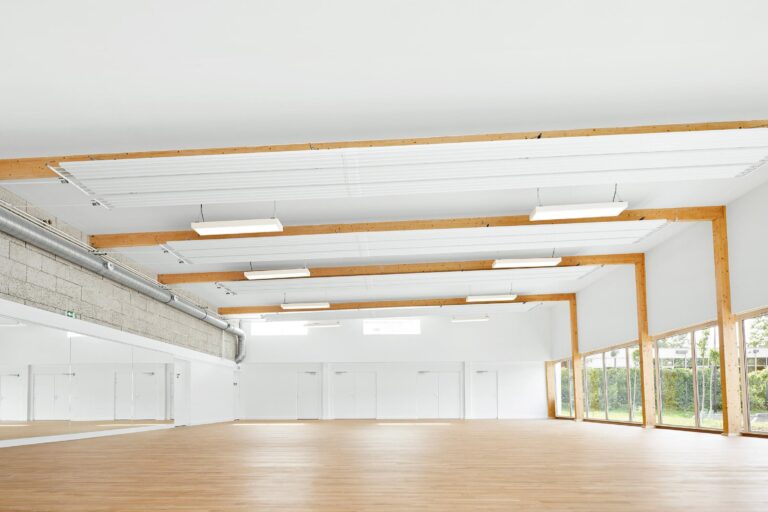France is pioneering a new approach to sustainable architecture with the construction of the Pierre Chevet sports hall, a groundbreaking facility built primarily from hemp. This innovative use of natural materials not only reduces the building’s carbon footprint but also positions the structure as a potential carbon sink, capable of absorbing more carbon dioxide than it emits. As climate concerns intensify, the Pierre Chevet sports hall exemplifies how eco-friendly construction techniques can contribute to environmental goals while meeting community needs.
Innovative Use of Hemp in Construction Promises Environmental Benefits
The Pierre Chevet sports hall in France represents a groundbreaking shift in sustainable architecture by leveraging hemp as a primary construction material. This innovative approach not only reduces carbon emissions during the building process but also gives the structure the potential to act as a carbon sink, absorbing more carbon dioxide over its lifetime than was emitted during construction. Hemp’s fast-growing, low-impact cultivation makes it an ideal candidate for eco-friendly building solutions, improving insulation while decreasing reliance on fossil-fuel based materials.
Beyond its environmental merits, hemp offers several practical advantages that are revolutionizing the construction sector:
- Lightweight yet durable: Reduces foundation costs and improves seismic performance.
- Natural pest resistance: Minimizes the need for chemical treatments.
- Excellent moisture regulation: Enhances indoor air quality and prevents mold.
With this model, industry experts anticipate a surge in hemp-based construction projects, potentially transforming urban landscapes into thriving regenerative ecosystems.
Engineering Challenges and Solutions in Building with Hemp Materials
The use of hemp materials in the construction of Pierre Chevet Sports Hall presents a unique set of engineering challenges, primarily due to the novelty of the material in large-scale public buildings. One significant hurdle was ensuring the structural integrity of hempcrete, a bio-composite material, against dynamic loads such as wind and vibrations typical in sports facilities. Engineers had to develop innovative reinforcement techniques, combining traditional wood frames with hempcrete panels, to meet safety standards without compromising sustainability goals. Moisture management also posed a technical challenge; the porous nature of hemp requires precise detailing to prevent water ingress and mold growth, necessitating advanced vapor barrier systems and smart ventilation solutions.
Another obstacle was optimizing thermal and acoustic performance while maintaining the carbon-negative potential of the construction. By leveraging hempcrete’s natural insulating properties, the design team was able to minimize the need for additional insulation materials, reducing embodied energy. The project incorporated elements such as:
- High-density hempcrete mixtures tailored for load-bearing walls
- Integrated sensor systems to monitor humidity and structural health in real-time
- Modular panel assembly that speeds construction and ensures precision
| Challenge | Solution | Benefit |
|---|---|---|
| Structural stability | Hybrid wood-hempcrete frame | Meets safety codes, sustainable design |
| Moisture control | Advanced vapor barriers & ventilation | Prevents decay, prolongs lifespan |
| Thermal efficiency | Customized hempcrete density | Reduced heating/cooling needs |
Potential of Sports Halls as Effective Carbon Sinks in Urban Areas
Urban sports halls like France’s Pierre Chevet facility are emerging as intriguing candidates in the fight against climate change due to their potential to function as effective carbon sinks. Constructed primarily from hemp, a rapidly renewable resource known for its exceptional carbon sequestration abilities, this sports hall not only provides a vibrant community hub but also actively contributes to carbon capture. The hemp fibers in the building materials absorb CO2 from the atmosphere during growth and continue to store carbon over the lifespan of the structure, thereby slowing down greenhouse gas accumulation in densely populated urban areas.
Beyond hemp’s natural properties, the design incorporates sustainable construction techniques aimed at maximizing environmental benefits. Features such as:
- Biobased insulation to minimize energy consumption,
- Wooden structural elements that lock in carbon for decades,
- Ventilation systems optimized for energy efficiency,
- Green rooftops to enhance urban biodiversity while absorbing CO2,
combine to enhance the facility’s carbon-negative potential. Below is a simplified comparison illustrating carbon sequestration estimates per construction material used:
| Material | Carbon Stored (kg CO2 / m3) | Longevity (years) |
|---|---|---|
| Hempcrete | 110 | 50+ |
| Wood | 150 | 80+ |
| Concrete (traditional) | -100 | 100+ |
Recommendations for Scaling Hemp-Based Architecture Across France
To unlock hemp’s full potential as a sustainable construction material across France, targeted policy support is paramount. Local and national governments should introduce incentives such as tax breaks and subsidies for builders and developers adopting hempcrete and other hemp-based composites. Additionally, streamlining certification processes and creating standardized building codes tailored for hemp architecture will boost industry confidence and safety compliance. Emphasizing collaborative efforts between research institutions, hemp farmers, and construction firms can further speed up innovation and practical applications.
Beyond policy, education and public awareness play a crucial role. Training programs for architects, contractors, and engineers are needed to bridge knowledge gaps around hemp’s benefits and technical performance. Public campaigns highlighting hemp’s carbon-negative footprint and thermal advantages could increase demand, encouraging scale. Below is a strategic roadmap outlining key actions, stakeholders, and expected impacts to facilitate the widespread adoption of hemp-based architecture:
| Strategic Action | Responsible Parties | Expected Impact |
|---|---|---|
| Financial Incentives | Government, Local Authorities | Increase adoption rate by 30% |
| Technical Training | Industry Bodies, Universities | Enhance construction quality and safety |
| Standardization & Certification | Standards Organizations, Regulatory Agencies | Ensure compliance and industry trust |
| Public Awareness Campaigns | NGOs, Media, Construction Firms | Boost consumer demand and social acceptance |
In Conclusion
As France’s commitment to sustainable construction gains momentum, Pierre Chevet sports hall stands out as a pioneering example of how innovative materials like hemp can transform public infrastructure into active carbon sinks. This project not only highlights the environmental benefits of bio-based building solutions but also sets a precedent for future developments aiming to reduce the construction industry’s carbon footprint. As more architects and policymakers take note, hemp-based construction could play a key role in France’s broader strategy to combat climate change and promote greener urban spaces.




